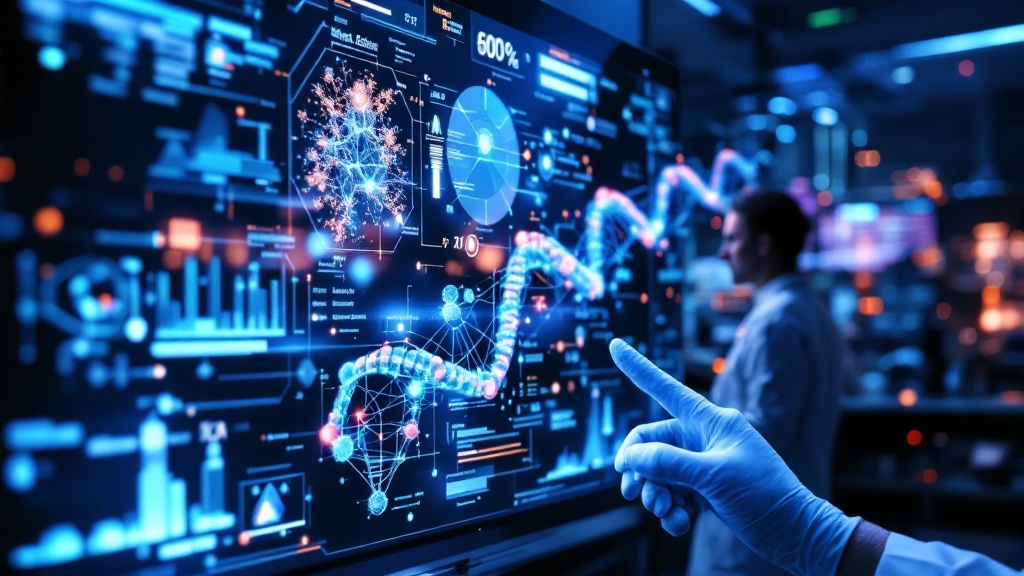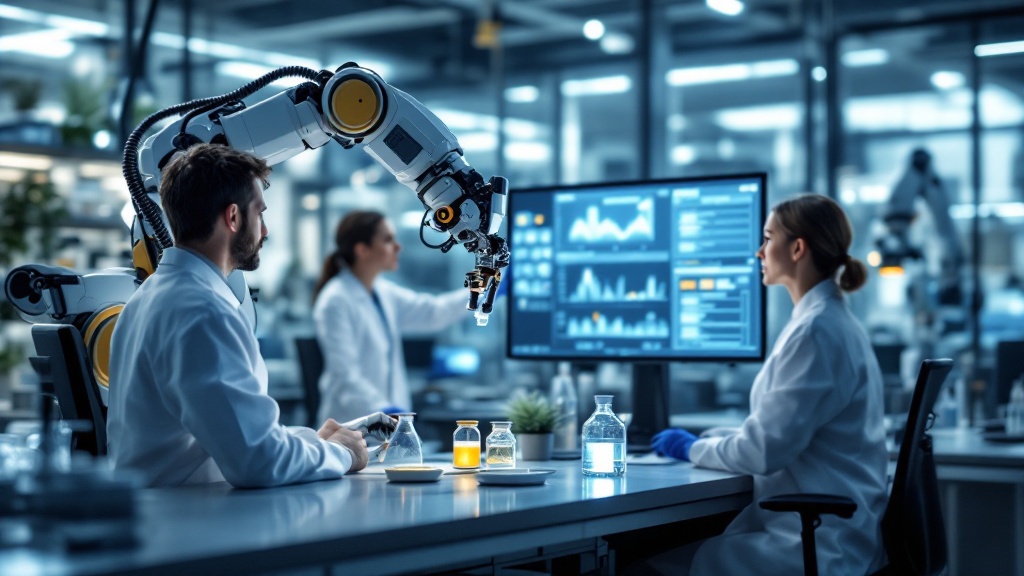Introduction
Artificial Intelligence (AI) is no longer a futuristic concept found only in science fiction—it is now an integral part of scientific progress. As of 2025, AI is deeply embedded in the heart of modern research, driving breakthroughs that would have taken decades through traditional methods alone. A 2024 Nature article reported that over 70% of leading research institutions now use AI-based tools for tasks such as data analysis, simulation, and prediction (Nature, 2024).
From decoding the complexities of the human genome to exploring the mysteries of the cosmos, AI is transforming not just the speed but also the accuracy, scope, and accessibility of scientific inquiry. With the integration of machine learning, neural networks, and generative models, the scientific community is stepping into a new era of accelerated innovation.

AI-Powered Data Analysis: Making Sense of Big Data
Modern scientific studies often produce colossal datasets that are too intricate for conventional analytical methods. AI, with its capacity to handle complexity and volume, excels in identifying patterns, correlations, and anomalies with minimal human intervention. In genomics, for instance, machine learning algorithms are used to sift through millions of DNA sequences, pinpointing genetic markers associated with specific diseases. In climate science, AI models are trained to process satellite imagery, geospatial data, and sensor inputs to provide real-time weather forecasts and long-term climate predictions with remarkable accuracy.
These tools don’t just save time—they also uncover insights that may remain hidden using traditional methods. Furthermore, AI can continually learn from new data, refining its predictions and growing more powerful over time. As datasets grow exponentially in both size and complexity, AI ensures that researchers stay ahead of the curve and can extract valuable knowledge quickly and reliably.
The role of AI in accelerating scientific breakthroughs is closely tied to the advancements described in How Does Large Language Models Work, where complex data processing enables faster insights.

Accelerating Drug Discovery and Medical Breakthroughs
AI is making a transformative impact in pharmaceutical and biomedical research. Traditionally, drug discovery is a costly, trial-and-error process that can take 10–15 years from inception to approval. AI significantly shortens this timeline by predicting molecular interactions, estimating potential efficacy, identifying toxicity risks, and proposing new compounds—often before a human even conducts a physical experiment.
Notable platforms like DeepMind’s AlphaFold have reshaped protein folding predictions, which are vital to understanding disease mechanisms and designing precision treatments. By 2025, AI-driven systems are routinely used not only to identify promising molecules but also to design smarter clinical trials and personalize treatments based on real-world patient data, including genomics, lifestyle, and environmental factors. AI’s role in diagnostics is also growing, enabling early detection of conditions like cancer and Alzheimer’s through pattern recognition in imaging and lab results.
AI’s growing contextual understanding, as discussed in AI is Becoming More Context-Aware and Emotionally Intelligent, helps researchers interpret nuanced data more effectively.

Enhancing Scientific Simulations and Modeling
Simulations are the backbone of theoretical research in fields such as astrophysics, quantum mechanics, and materials science. These simulations are often computationally intensive, demanding high-performance computing resources and long processing times. AI changes the game by enhancing simulation efficiency, speeding up calculations, and reducing resource consumption.
Neural networks and generative models can now simulate extremely complex phenomena—like the behavior of subatomic particles or the dynamics of climate systems—in a fraction of the time compared to traditional models. Moreover, AI supports adaptive modeling, where systems evolve based on real-time data and feedback, producing results that improve over time. This makes hypothesis testing, scenario planning, and prediction not only faster but also more precise, allowing researchers to explore more ambitious scientific questions.
The use of AI-powered tools in research parallels their applications in business growth covered in How AI-Powered Tools Can Help You Scale Your Business Faster.

Automating Repetitive Research Tasks
In laboratories worldwide, a significant portion of researchers’ time is consumed by repetitive manual tasks. These include pipetting, labeling images, preparing slides, and calibrating instruments. With the introduction of AI-driven automation and robotics, these routine processes are being streamlined, leading to higher efficiency and lower error rates.
In 2025, AI-powered robotic systems are capable of running experiments continuously, day and night, significantly increasing throughput and data quality. These autonomous labs can test thousands of experimental conditions and record detailed observations that human researchers might overlook. Meanwhile, AI also aids in documentation, real-time monitoring, and automatic error detection, freeing scientists to focus on critical thinking, innovation, and interpretation. This combination of automation and intelligence is reshaping laboratory workflows across all scientific disciplines.
Reinforcement learning from human feedback is accelerating AI improvements that boost research productivity, as explored in The Power of Data Scaling in Reinforcement Learning from Human Feedback.

Democratizing Scientific Discovery
Perhaps one of the most profound impacts of AI in science is its ability to level the playing field. Through open-source platforms, cloud-based research environments, and affordable AI tools, scientific exploration is becoming more accessible than ever. Institutions that once lacked the infrastructure or funding to conduct advanced research can now participate in global scientific dialogues and contribute to meaningful discoveries.
Tools such as GPT-powered research assistants help users generate literature reviews, summarize studies, translate texts, and even prepare grant proposals. For example, platforms developed by GEE-P-TEE offer customizable AI tools tailored for different research disciplines, allowing users to perform complex tasks with minimal technical expertise. These innovations not only empower smaller labs and universities in underfunded regions but also promote inclusivity and diversity in the scientific workforce, leading to richer and more innovative research outcomes.
Scientific research is also benefiting from AI-enhanced text generation techniques found in The Science of AI-Powered Text Generation, helping automate literature reviews and reports.

Conclusion
AI in 2025 is no longer a novelty—it’s a powerful engine of progress, transforming the way science is conducted across disciplines. From deciphering vast datasets to simulating the universe’s deepest mysteries, AI is accelerating every step of the research journey. It enables scientists to move faster, work smarter, and explore questions that were previously out of reach.
More importantly, AI is making science more inclusive, opening doors for global collaboration and enabling a broader spectrum of voices to engage in discovery. As the technology continues to evolve, we can expect an even greater synergy between human intuition and machine intelligence. The future of science is undeniably intertwined with AI, not as a replacement for researchers but as a trusted partner in pushing the boundaries of human knowledge further than ever before.

Leave a Reply